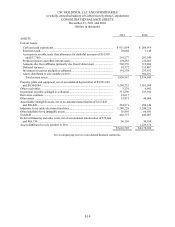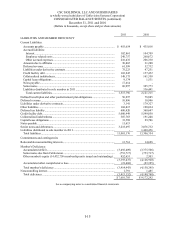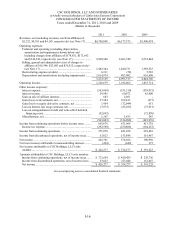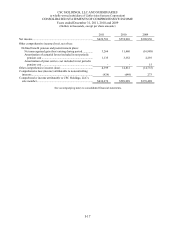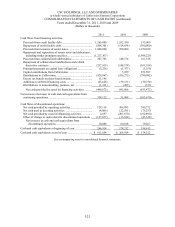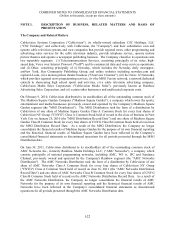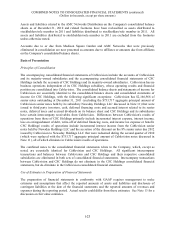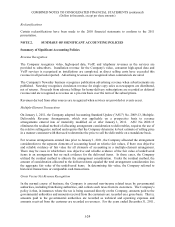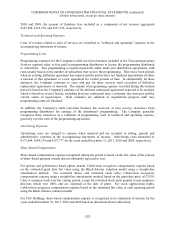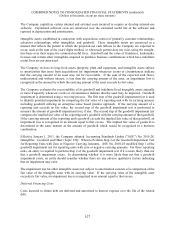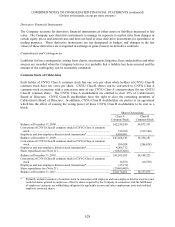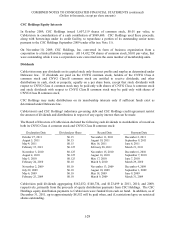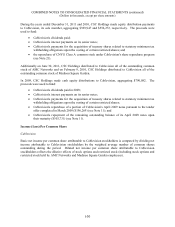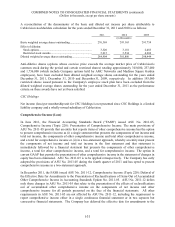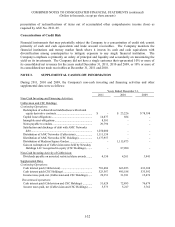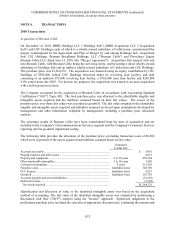Cablevision 2011 Annual Report Download - page 148
Download and view the complete annual report
Please find page 148 of the 2011 Cablevision annual report below. You can navigate through the pages in the report by either clicking on the pages listed below, or by using the keyword search tool below to find specific information within the annual report.COMBINED NOTES TO CONSOLIDATED FINANCIAL STATEMENTS (continued)
(Dollars in thousands, except per share amounts)
I-24
Reclassifications
Certain reclassifications have been made to the 2010 financial statements to conform to the 2011
presentation.
NOTE 2. SUMMARY OF SIGNIFICANT ACCOUNTING POLICIES
Summary of Significant Accounting Policies
Revenue Recognition
The Company recognizes video, high-speed data, VoIP, and telephony revenues as the services are
provided to subscribers. Installation revenue for the Company's video, consumer high-speed data and
VoIP services is recognized as installations are completed, as direct selling costs have exceeded this
revenue in all periods reported. Advertising revenues are recognized when commercials are aired.
The Company's Newsday business recognizes publication advertising revenue when advertisements are
published. Newsday recognizes circulation revenue for single copy sales as newspapers are distributed,
net of returns. Proceeds from advance billings for home-delivery subscriptions are recorded as deferred
revenue and are recognized as revenue on a pro-rata basis over the term of the subscriptions.
Revenues derived from other sources are recognized when services are provided or events occur.
Multiple-Element Transactions
On January 1, 2011, the Company adopted Accounting Standard Update ("ASU") No. 2009-13, Multiple-
Deliverable Revenue Arrangements, which was applicable on a prospective basis to revenue
arrangements entered into or materially modified on or after January 1, 2011. ASU No. 2009-13
eliminates the residual method of allocating arrangement consideration to deliverables, requires the use of
the relative selling price method and requires that the Company determine its best estimate of selling price
in a manner consistent with that used to determine the price to sell the deliverable on a standalone basis.
For revenue arrangements entered into prior to January 1, 2011, the Company allocated the arrangement
consideration to the separate elements of accounting based on relative fair values, if there was objective
and reliable evidence of fair value for all elements of accounting in a multiple-element arrangement.
There may be cases in which there was objective and reliable evidence of the fair value of undelivered
items in an arrangement but no such evidence for the delivered items. In those cases, the Company
utilized the residual method to allocate the arrangement consideration. Under the residual method, the
amount of consideration allocated to the delivered items equaled the total arrangement consideration less
the aggregate fair value of the undelivered items. In determining fair value, the Company referred to
historical transactions or comparable cash transactions.
Gross Versus Net Revenue Recognition
In the normal course of business, the Company is assessed non-income related taxes by governmental
authorities, including franchising authorities, and collects such taxes from its customers. The Company's
policy is that, in instances where the tax is being assessed directly on the Company, amounts paid to the
governmental authorities and amounts received from the customers are recorded on a gross basis. That is,
amounts paid to the governmental authorities are recorded as technical and operating expenses and
amounts received from the customer are recorded as revenues. For the years ended December 31, 2011,


